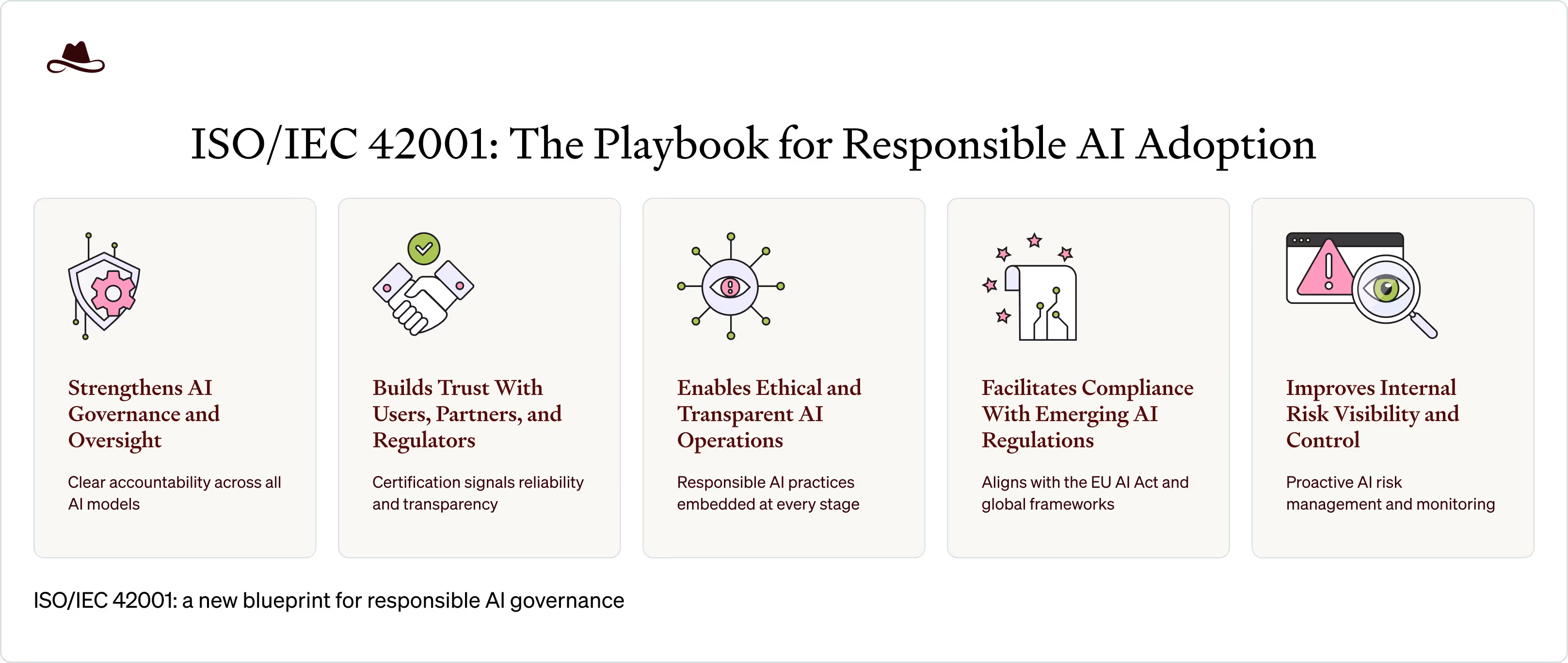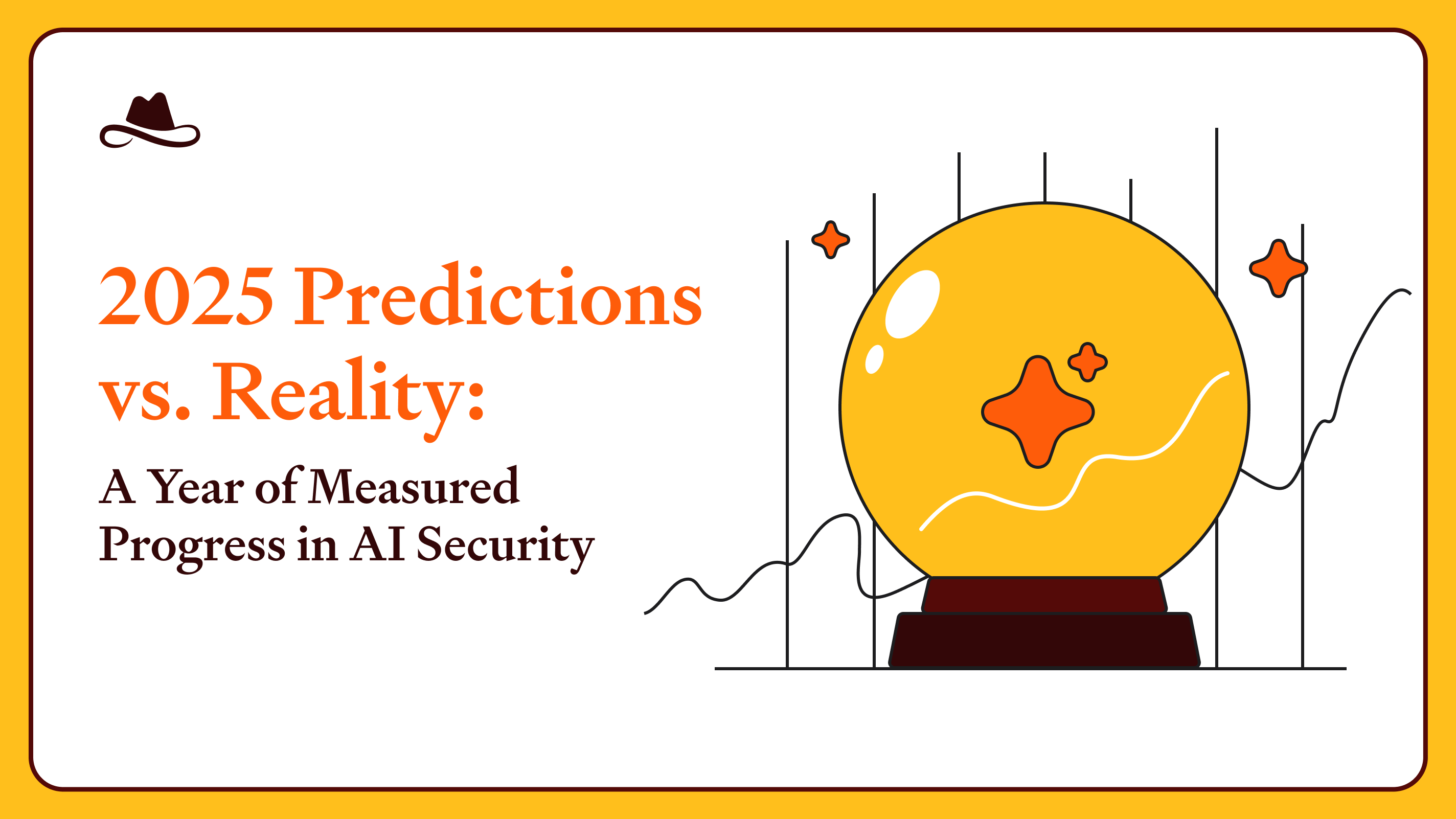As the world’s first standard for AI management systems (AIMS), ISO/IEC 42001 is still relatively fresh. It arrived in late 2023, just as GenAI hype was winding down, and boardroom panic was picking up. Shortly after ISO/IEC 42001 emerged, the EU AI Act came into force, pushing responsible AI governance to the very top of enterprise priorities.
As a rule, it may not be battle-tested yet. But it is thorough, and it’s already shaping how enterprises build, deploy, and regulate their AI models. This article covers what ISO/IEC 42001 is, the challenges and best practices for implementation, how it connects to the EU AI Act, and how your organization can prepare for compliance while keeping AI innovation on track.
What is ISO/IEC 42001?
ISO/IEC 42001 is the world’s first international standard for Artificial Intelligence Management Systems (AIMS). Published in December 2023 by the International Organization for Standardization (ISO) and the International Electrotechnical Commission (IEC), it provides a structured framework for organizations to manage AI responsibly.
The standard covers governance, risk management, transparency, and ethical use across the AI lifecycle. Unlike sector-specific guidelines, ISO/IEC 42001 is designed to be broadly applicable, helping enterprises demonstrate accountability and align with emerging regulations such as the EU AI Act. If you’re preparing your compliance roadmap for 2025, you can access our recent webinar on the interaction between the EU AI Act and ISO 42001.
ISO/IEC 42001 vs ISO/IEC 27001 vs SOC 2
ISO/IEC 42001 is the latest addition to the family of enterprise governance and security frameworks that includes ISO/IEC 27001 and SOC2.
- ISO/IEC 27001 is foundational. It establishes an information security management system (ISMS). Many enterprises start here because it covers the broadest range of security controls.
- SOC 2 builds on similar principles, but it’s a customer-facing assurance. Where ISO 27001 is about your internal management system, SOC 2 demonstrates to clients that your service operations meet security and privacy expectations.
- ISO/IEC 42001 extends the governance mindset specifically to AI, layering on transparency, accountability, and ethical use.
Types of ISO/IEC 42001 Certification
As organizations adopt an AI management system (AIMS) under ISO/IEC 42001, there are several paths to maturity and assurance. Below is a breakdown of common certification or assessment approaches:
Full Certification
Full certification under ISO/IEC 42001 is the formal path, similar in structure to certifications like ISO/IEC 27001 or ISO 9001. An accredited conformity assessment body (CAB) conducts a comprehensive audit of an organization’s AI management system (AIMS), checking AI compliance against the complete set of requirements in the standard. If successful, the enterprise is awarded certification, typically valid for three years with annual or semi-annual surveillance audits to ensure ongoing compliance. This process requires organizations to demonstrate controls across all clauses and annexes, covering risk management, governance, transparency, bias mitigation, human oversight, and lifecycle monitoring. This process is resource-intensive and demands long-term maturity, not just a one-time alignment exercise.
Pre-Certification Assessment
Many enterprises begin with a pre-certification assessment before attempting the full ISO/IEC 42001 audit. This stage functions as a diagnostic exercise, benchmarking current AI governance and risk management practices against the standard’s requirements. Conducted by internal teams, external consultants, or even prospective certification bodies, the assessment highlights gaps, weaknesses, and areas needing remediation. The result is a structured roadmap that prioritizes risks, outlines remediation steps, and estimates resources required to close compliance gaps. For most organizations, this readiness phase reduces the likelihood of audit failure, builds internal alignment, and provides a clearer path toward a successful certification outcome.
Overview of AI Management System Requirements (AIMS)
- Context and Scope (Clause 4): Define the scope of your AI management system, identify stakeholders, and establish how AI projects align with business and regulatory needs.
- Leadership (Clause 5): Secure top management commitment, set AI policy, and assign accountability for responsible AI governance.
- Planning and Risk Assessment (Clause 6): Identify AI risks and opportunities, conduct impact assessments (bias, ethics, security, safety), and set measurable objectives.
- Support (Clause 7): Ensure adequate resources, skills, awareness, and documentation to sustain the AI management system.
- Operation (Clause 8): Establish controls over AI development, deployment, and monitoring, including validation, change management, and human oversight.
- Performance Evaluation (Clause 9): Continuously monitor and audit Generative AI, with management reviews and clear reporting mechanisms.
- Improvement (Clause 10): Drive continual improvement through corrective actions, learning from nonconformities, and adapting to evolving risks.
Features and Components of ISO/IEC 42001
Governance Principles for AI
At its core, ISO/IEC 42001 establishes a structured AI management system that enforces clear governance principles. Much like other international organizational (ISO/IEC) standards, it emphasizes accountability, leadership responsibility, and oversight mechanisms to ensure that GenAI is developed and deployed with transparency and integrity.
Ethical AI Guidelines
The standard embeds responsible AI practices directly into the artificial intelligence management system (AIMS). This includes requirements for human oversight, bias mitigation, explainability, and fairness. These are built to reassure both regulators and end users that their AI technologies are deployed in a trustworthy way.
Risk Management Controls
A key component of ISO/IEC 42001 is AI risk management. Organizations must conduct ongoing risk assessments to identify, evaluate, and mitigate threats that arise across the AI lifecycle. This covers technical vulnerabilities as well as ethical and regulatory risks.
Documentation and Record Keeping
Organizations must maintain model cards, audit logs, decision records, and compliance reports to support accountability. This documentation not only helps with external audits but also enables traceability, creating a clear record of how AI projects are governed over time.
Structure of the ISO/IEC 42001 Standard
The structure of ISO/IEC 42001 mirrors that of other ISO management system standards, organized into Clauses 4-10: Context, Leadership, Planning, Support, Operation, Performance Evaluation, and Improvement. Together, these provide the foundation for building a sustainable artificial intelligence management system that integrates with existing standards like ISO/IEC 27001 for information security or ISO 9001 for quality.
How ISO/IEC 42001 Guides AI Adoption
- Strengthens AI Governance and Oversight: Embeds governance across departments, ensuring clear ownership of AI decision-making.
- Builds Trust With Users, Partners, and Regulators: Certification demonstrates alignment with global standards, boosting stakeholder confidence.
- Enables Ethical and Transparent AI Operations: Embeds responsible AI principles into every stage of AI management.
- Facilitates Compliance With Emerging AI Regulations: Supports alignment with frameworks like the EU AI Act, GDPR, and other regional laws.
- Improves Internal Risk Visibility and Control: Provides structured processes to identify and mitigate AI risks before they escalate.

How to Achieve ISO/IEC 42001 Compliance in 6 Steps
- Define Organizational Context
Establish the scope of your AI management system, map stakeholders, and align AI use cases with business strategy. - Gain Leadership Commitment
Secure executive buy-in, assign roles, and embed AI governance into leadership responsibilities. - Perform Risk and Impact Assessment
Conduct comprehensive risk assessments across your AI projects, including technical, ethical, and regulatory impacts. - Establish Operational Planning and Controls
Implement controls for AI development, deployment, monitoring, and oversight, ensuring responsible use of AI technologies. - Monitor and Evaluate Performance
Continuously audit and review the artificial intelligence management system to ensure it remains effective, accurate, and compliant. - Drive Continuous Improvement
Treat the AIMS as a living system. Identify nonconformities, adapt to evolving regulations, and enhance practices in line with responsible AI governance.
ISO/IEC 42001 Implementation Challenges & Solutions
Best Practices for ISO/IEC 42001
A successful AI management system under ISO/IEC 42001 is one that embeds responsible AI governance into every part of the organization.
Step 1: Map AI Risks Across the Lifecycle
Visibility is the cornerstone of effective AI risk management. Every AI project should undergo a full risk assessment that covers the entire lifecycle, beginning with data collection and model training through to deployment and monitoring. This assessment should document potential vulnerabilities like bias, security gaps, and misuse. By mapping risk throughout the AI development lifecycle in this way, enterprises can design responsible AI practices in, right from the start, rather than bolting on controls later.
Continuous Monitoring and Reporting
Conventional solutions cannot manage AI risk, because AI models don’t stay static. They drift, their behaviors evolve, and new threat vectors keep emerging. Continuous monitoring is crucial when designing an artificial intelligence management system. Organizations need to deploy automated logging, anomaly detection, and compliance dashboards for ongoing assurance and audit trails.
Harmonize With Existing Standards
The AI management requirements of ISO/IEC 42001 can and should be harmonized with other frameworks like ISO/IEC 27001 (for InfoSec), or SOC 2 (for service assurance). Integrating AI-specific controls into the compliance stack helps to avoid duplication of effort while demonstrating a broad-based commitment to responsible AI governance.
Team Training and Awareness Programs
AI technologies can fail in practice if employees don’t know their roles in safe deployment. Organizations should prioritize bringing IT, compliance, product and data science onto the same page, ensuring each team knows their responsibilities. Awareness programs and workshops may be needed to help all of these teams arrive at a common understanding, and establish a security-minded culture.
How Lasso Simplifies ISO/IEC 42001 Readiness and Compliance
Achieving ISO/IEC 42001 compliance can feel daunting. The standard asks enterprises to treat AI with the same rigor as information security or quality management. For many organizations, that means building new processes, retraining teams, and integrating oversight into fast-moving AI projects. That’s a considerable challenge, even for mature compliance functions.
Lasso makes this journey far more manageable. Our platform provides always-on visibility into AI applications, agents and models, continuous monitoring to support audits, and customizable policies that align with the clauses of ISO/IEC 42001. By embedding responsible AI practices into daily operations, Lasso helps organizations demonstrate compliance with emerging requirements like the EU AI Act, while reducing the overhead typically associated with manual assessments and documentation.
Accelerate your path from pre-certification to full readiness, without sacrificing innovation. Lasso ensures your AI management system stays secure, compliant, and ready for what’s next.

.avif)

.png)
.avif)

